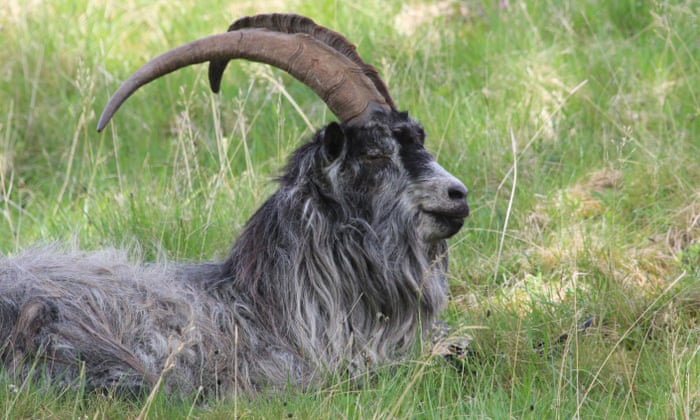Four billy goats with a tale to tell
Coignafearn, Highlands There is something about wild goats that appeals to me – perhaps their look of superiority?
A wild billy goat sitting down in the shade of a birch. Photograph: Ray Collier
Standing
on the side of the burn, I watched the water flow past my feet,
gurgling and murmuring as it continued on its way to the river Findhorn below. After the cold spring, the spring and early summer plants were all flowering together. The yellow carpets of bird’s foot-trefoil,
or “eggs and bacon” as I prefer to call it, dominated the scene. On the
drier areas were small groups of mountain pansies whose flowers varied
from red to intense violet.
The butterworts in the splash zone of the burn were such an outstanding purple that their tiny flowers looked much larger than they actually were. Lady’s smock plants – also known as cuckooflowers, because they bloom when the first cuckoo begins calling – stood out above the others. Their slender stems topped with tiny pale lilac flower heads looked as if they were just waiting for an orange tip butterfly to lay its tiny orange eggs on them.
Large tracts of junipers, blue-green in the strong sunshine, have spread up the hillsides, making them impenetrable in places. On the scalloped margins, browsing by red deer on the outer shoots has formed unusual shapes, like topiary. Junipers are among my favourite shrubs, although, as they stand up to two metres high, perhaps “trees” would be a better word.
The butterworts in the splash zone of the burn were such an outstanding purple that their tiny flowers looked much larger than they actually were. Lady’s smock plants – also known as cuckooflowers, because they bloom when the first cuckoo begins calling – stood out above the others. Their slender stems topped with tiny pale lilac flower heads looked as if they were just waiting for an orange tip butterfly to lay its tiny orange eggs on them.
Large tracts of junipers, blue-green in the strong sunshine, have spread up the hillsides, making them impenetrable in places. On the scalloped margins, browsing by red deer on the outer shoots has formed unusual shapes, like topiary. Junipers are among my favourite shrubs, although, as they stand up to two metres high, perhaps “trees” would be a better word.
Coignafearn is a strath favoured by golden eagles and peregrines as a hunting area, but even with binoculars I could not spot any of these raptors. However, as I was scanning the open hillsides I did have a strong feeling that I was being watched. Eventually I spotted them. Four large, dark, wild billy goats, sitting down in the shade of a solitary birch tree, all panting in the heat.
There is something about wild goats that appeals to me – perhaps their look of superiority? All four billies had huge, gracefully curved horns, and I counted the annual growth rings on one. He was between eight and nine years old. What stories he could tell of his tribe in that strath. I nodded my head in respect and left.
Follow Country diary on Twitter: @gdncountrydiary
Topics
Wildlife
Summer
Rural affairs
Plants
Scotland
https://www.theguardian.com/environment/2016/jun/25/four-wild-billy-goats-highlands-scotland-country-diary#img-1

No comments:
Post a Comment